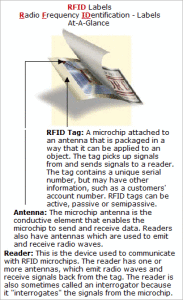RFID LABELS
RADIO FREQUENCY IDENTIFICATION is an automatic identification method, relying on storing and remotely retrieving data using devices called RFID tags or transponders. An RFID tag is an object that can be applied to or incorporated into a product, animal, or person for the purpose of identification using
radio waves. Some tags can be read from several meters away and beyond
the line of sight of the reader.
Vendors use RFID printer/encoders to label cases and pallets that require EPC tags for companies such as Wal-Mart, and Amazon. These smart labels are produced by embedding RFID inlays inside the label material, and then printing bar code and other visible information on the surface of the label.
Global Venture’s years of experience and commitment offers innovative RFID applications to its clients. Our strategic alliances forged with leading inlay manufacturers, and hardware and software companies, enables us to provide a total RFID solution. Whether it is closed loop application or a mandate, we partner with clients to serve their needs. Our unique conversion process keeps us extremely competitive in offering a wide variety of RFID labels and tags.
What Is Radio Frequency Identification (RFID)?
A method of identifying unique items using radio waves. Typically, a reader communicates with a microchip embedded in a label which holds digital information.
How Does RFID Work?
Think of RFID as a system of several key components. These components are: a a microchip with an antenna, a label that “carries” the microchip and a reader with an antenna that receives the microchip’s signal. The reader sends out electromagnetic waves. The microchip’s antenna is tuned to receive these waves. The chip then modulates the waves that the antenna sends back to the reader and the reader converts the new waves into digital data.
Why Is RFID In Demand?
RFID can have many benefits, from controlling shrinkage in retail environments to speeding distribution throughout entire supply chains to tracking individual purchases to specific items and so on. The uses are many and varied – based on saving resources or gathering valuable data or both.
The real limits to RFID have more to do with costs of implementation an ongoing use and support than they do with the actual benefits available. RFID can be costly and the business that looks into RFID needs to be very specific about their expected return on investment. That said, RFID is used by thousands of companies – and growing daily.
Who Is Using RFID Labels?
As RFID technology costs diminish, more and more businesses are relying on RFID. From wholesale distribution to retail sales from animal tracking to property protection, RFID is used across all industries.
Recently, the big box retailers like Wal-Mart have introduced initiatives to ultimately place an RFID label on every item they sell. While it may be some time before consumers take home a bag of RFID products, the emerging trends are clearly leading in that direction.
